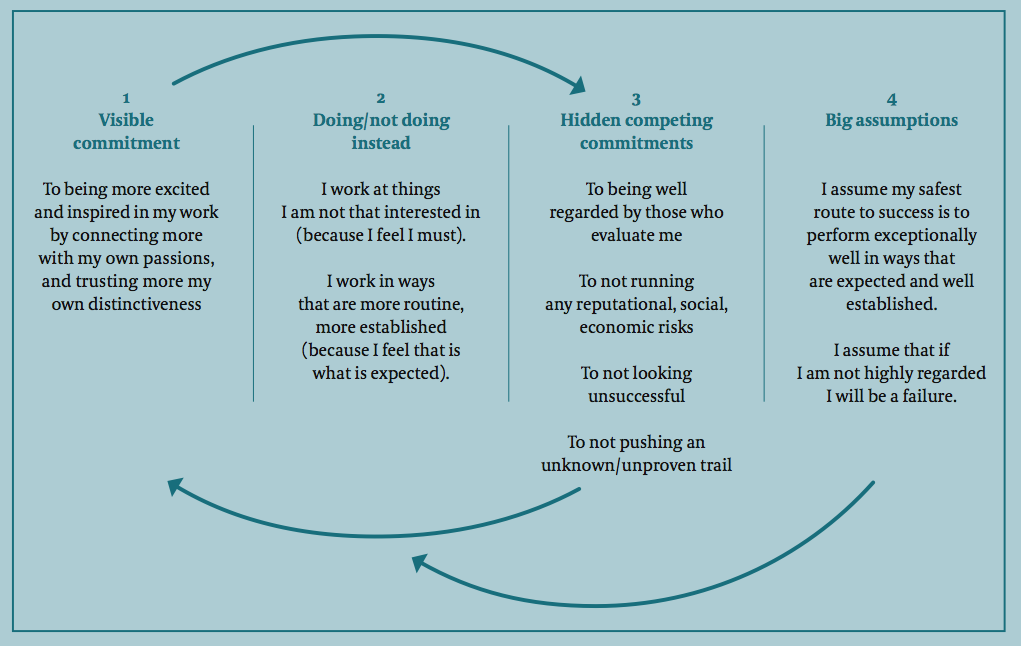The core of being an executive is making choices, yet senior leadership development often overlooks a vital dimension of how leaders actually make choices. A leader’s “hidden commitments” can create an “immunity to change” and drive behaviors that work against fulfilling the leader’s key development goals. The solution, the authors suggest, starts with sketching the individual’s immunity map – an innovative tool developed by Harvard University’s Robert Kegan and Lisa Lahey. Fortifying traditional senior leadership development with immunity maps can help leaders to quickly identify and resolve unseen inner conflicts, and so more rapidly fulfill their leadership potential.
Scientific research has arrived at two important insights which, considered together, point to an irony of organizational life – and a wealth of opportunity.
On the one hand, science has revealed that adults are far more capable of lifelong learning, development, and change than was long believed. Sustained “neural plasticity” in the human brain allows adults to continually retrain their brains to work in new and different ways. In other words, it is within your power to significantly reshape who you are throughout adult life.
Equally valid research reveals a potent counterforce: adults can unwittingly undermine their own pursuit of change. Even as they hold a sincere commitment to move in a new direction, they apply much of their productive energy to hidden competing commitments that compel them to essentially do the opposite. The result is an innate and unseen “immunity to change.” For example, a manager who recognizes that she must become a better delegator to earn a desired promotion may nevertheless continue to exert excessive control because, deep down, she believes her team may not perform well, and this will reflect poorly on her. Alternatively, she may believe that her team will perform so well, she will be marginalized. The unspoken commitment to prevent a damaging underperformance by her team (or to avoid losing her indispensability) subconsciously trumps the spoken commitment to delegate more authority.
Another manager may drag his feet on a showcase project he is genuinely thrilled to lead because he silently fears that success in the current endeavor may earn him responsibility for an even tougher project that he could not handle. Hesitation in the present subconsciously protects him from an envisioned future embarrassment. In such cases, what appears to be willful refusal to change or an inexplicable failure to perform actually stems from an unseen standoff between the leader’s stated commitment and a hidden competing commitment to protect himself from some imagined, impending loss.
The good news? Organizations can readily counter the involuntary, negative effects of an immunity to change. By doing so, they unlock fresh reservoirs of leadership and performance potential. Understanding immunities to change is vitally important for effective leadership development and for retaining valuable leadership talent.
Beyond skill or will
The core of being an executive is making choices – often, highly consequential choices. As such, senior leadership development must help rising leaders understand how they actually make choices, which includes exploring their unconscious mental frameworks. Traditional leadership development rarely addresses these powerful hidden forces that so frequently hinder leaders’ growth and ability to move in new directions.
The curricula of most leadership development programs do evolve as leaders advance toward executive roles. Early leadership development is weighted toward technical knowledge and skills. Fledgling leaders learn their function and build the skills required to do their jobs. In contrast, by the time leaders are poised to tackle more senior roles, they have already demonstrated command of the requisite technical knowledge and skills.
At this point, what the leader knows and can do are mostly a given. The critical variable becomes who the leader is. As such, senior leadership development appropriately focuses more on the personal traits of a leader – including his belief system and his mental map of himself and the world that surrounds him.
This evolutionary approach is very effective, as far as it goes. However, when promising leaders act in ways that appear bafflingly inconsistent with their stated goals, traditional leadership development offers few useful answers. Most organizations will ask: “Is this a question of skill or will?” Sometimes the obstacle can be found and remedied at those levels. Other times, you may find that the leader possesses both the skills required to make an important change and a sincere will to do so – yet mysteriously remains stuck. This is when you should probe for an immunity to change, which is yet another profoundly important dimension of who the leader is.
Exploring leadership personality
Leaders need not engage in lengthy psychoanalysis to gain penetrating insight into their hidden commitments. Using a tool called the immunity map – which much like an X-ray, reveals what exists beneath the surface – a skilled advisor can quickly help leaders identify internal obstacles and determine how to approach them to bring about new results. The immunity map is firmly grounded in sound psychological theory and is the product of many years of research in real work settings across business, government, and education. It was shaped with the participation of a wide range of leaders – CEOs, senior managers, commissioners, superintendents – who had the courage to look deeply within for hidden truths.
Over the past year, we have jointly explored how immunity maps might fortify traditional senior leadership development. The results are encouraging. This framework has proven easy to apply and very effective in practice. Surfacing leaders’ hidden commitments consistently yields breakthroughs in their capacity to adapt and grow.
This example of an immunity map, drawn from Kegan and Lahey’s book Immunity to Change: How To Overcome It And Unlock The Potential In Yourself And Your Organization (Harvard Business Press), reveals how one junior executive’s subconscious competing commitments were effectively preventing him from blossoming into the kind of bold, dynamic senior leader his organization needs him to be. While his actual behavior (“doing / not doing instead”) contradicts his explicit, visible commitment – it serves his hidden commitments very well. As long as it is sustained by unquestioned “big assumptions” any change of the actual behavior is very unlikely.
In dialogue with a developing leader, a trained and trusted advisor can use this simple four-column framework to probe two or more levels deep into the personality governing the leader’s choices. When leaders discover what a powerful force their unseen competing commitments truly are, they tend to be intrigued, then excited about the opportunity to resolve frustrating inner conflicts and realize professional and personal growth.

Focus on achievement
Leaders first articulate a visible commitment – something they clearly want to achieve because they recognize it is vital to their continued success and advancement. As illustrated in the sample immunity map, a rising executive’s column 1 commitments may be quite personal in nature. This is entirely appropriate as many keys to executive success are, in fact, personal.
The leader next identifies obstructive behaviors. What are they doing/not doing that works against fulfilling the column 1 commitment? Instead of regarding these behaviors as things that just need to go away, we see them as valuable information that can be mined to gain a deeper understanding of how the leader actually makes choices. This deeper understanding is realized when leaders explore and identify the motivating forces behind their obstructive behaviors – the vitally important hidden commitments.
Finally, the immunity map invites the leader to delve one level deeper to surface the big assumptions behind the hidden commitments. These unspoken and often unconscious assumptions are the ultimate source of the anxiety shaping the leader’s obstructive behaviors, and so can be the gateway to substantial, lasting change and great leaps forward in the leader’s development.
Redrawing immunity systems
The immunity X-ray offers a schematic representation of the way a person is handling not an acute or episodic anxiety, but a constant, if unrecognized, anxiety running continuously through his or her life. This psychological system of countervailing forces is geared to selfpreservation. However, when our immune system rejects new material (whether it is a new organ or a new belief) that we actually require to heal or to thrive, it can put us in danger. In these instances the immune system is no less focused on protecting us. It is just making a mistake. It does not understand that it must alter its code. It does not understand that, ironically, in working to preserve us, it is actually putting us at serious risk.
Fortunately, misguided immune systems can be overcome. Too constricting an anxiety-management system can be replaced with a more expansive one. To overcome an immunity to change, leaders stop making what they now understand is actually a bad bargain: their immune systems have been giving them relief from anxiety while creating a false belief that certain things are impossible for them to do, when in truth their visible goals may be completely attainable! Leadership advisors help leaders to systematically consider their hidden beliefs, then replace false or overly restrictive beliefs with new beliefs. This work proceeds at whatever pace the leader can accommodate, but quite often leaders can redraw their immunity systems within a few months, bringing their big assumptions more into harmony with their visible commitments.
The goal is never to destroy a leader’s immune system, which is an essential part of who leaders are and so must be acknowledged, honored, and healthily incorporated into each leader’s development pathway. Rather, the object is to help leaders see how they might consciously modify their psychological immune systems to continue to provide essential internal protections, while also permitting the accomplishment of their stated goals.
“Where traditional approaches fall short, addressing immunity to change may well prove effective, largely because an immunity map zooms in on the root causes of the presenting problem.”
The case for innovation
The case for integrating this innovation into senior leadership development is compellingly clear.
Worldwide, VUCA (volatility, uncertainty, complexity, and ambiguity) makes leadership increasingly difficult. Why compound the challenge by allowing executives to remain hobbled by inner conflicts that could be resolved with relative ease? Immunity maps provide a powerful new option for removing major obstacles to leaders’ growth and advancement without contradicting any of the other methodologies commonly applied in senior leadership development.
In economic terms, many organizations report that their investments in leadership development fail to resolve performance issues or meaningfully accelerate leaders’ growth. Immunity maps can reveal a crucial missing piece in the puzzle of why change is so difficult. Where traditional approaches fall short, addressing immunity to change may well prove effective, largely because an immunity map zooms directly in on the root causes of the presenting problem. Thoughtfully building this practical tool into senior leadership development can tangibly improve return on your development investment, as leaders will consistently develop faster and stumble less often.
Helping executives resolve hidden commitments will also help companies retain their best leadership talent, because leaders with minimal inner conflict experience less negative stress and feel more content and fulfilled by their work lives.
For all these reasons and more, thoughtfully integrating immunity to change into senior leadership development can be a game-changer - for developing leaders, and for the companies they will lead.

Robert Kegan
is the Meehan Professor of Adult Learning and Professional Development at the Harvard University Graduate School of Education, and co-author of Immunity to Change: How To Overcome It And Unlock The Potential In Yourself And Your Organization (Harvard Business Press, 2009). His thirty years of research and writing on adult development have contributed to the recognition that ongoing psychological development after adolescence is at once possible and necessary to meet the demands of modern life. He is the recipient of numerous honorary degrees and awards. His seminal books, The Evolving Self and In Over Our Heads, have been published in several languages.

Lisa Lahey
is Co-Director of Minds At Work, a professional services firm serving businesses and institutions around the world; and faculty at the Harvard University Graduate School of Education. She teaches in executive development programs at Harvard University and Notre Dame, and is regularly asked to present her work throughout the world, most recently in China, Kazakhstan, and New Zealand. Her co-authored books, How The Way We Talk Can Change The Way We Work (2001) and Immunity to Change (2009), have been published in many languages. Lisa has been on the faculty of the World Economic Forum’s Davos Conference. Her work has been featured in the Harvard Business Review, The New York Times Sunday Business Section, Oprah Magazine, and Fast Company.

Jens Riedel
is a partner in Egon Zehnder’s office in Berlin, Germany. He conducts executive search projects, management appraisals and supports the development of senior leaders in defining development agendas and as an executive coach. One key finding of his PhD dissertation on executive coaching was that conflicting goals are the most common issue that needs to be addressed in coaching. He also co-leads the Risk Management segment of Egon Zehnder’s global Financial Services Practice.





